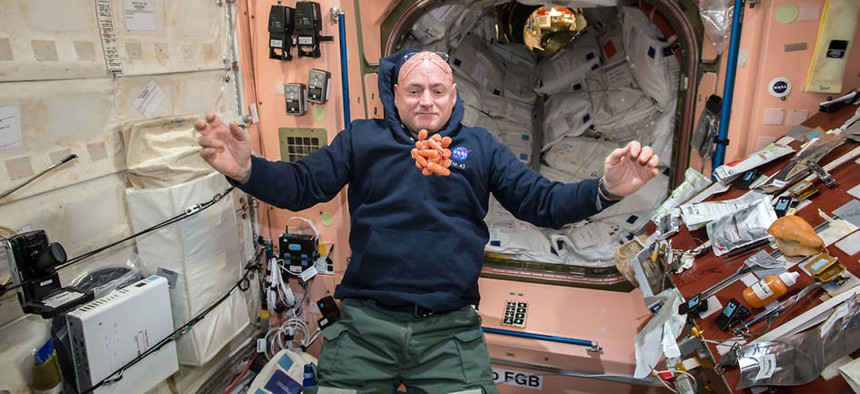NASA Wants to Turn Human Waste into Plastic and Vitamins

Snack time on the International Space Station as NASA astronaut Scott Kelly watches a bunch of fresh carrots float in front of him while preparing to partake of their crunchy goodness. NASA
When tomorrow’s astronauts feel the call of nature, they may be engaging in an act of creation.
When tomorrow’s astronauts feel the call of nature, they may be engaging in an act of creation. NASA recently awarded roughly $200,000 to researchers at Clemson University to figure out how to turn human waste into usable products, including vitamins and plastics.
Mark Blenner, a professor in Clemson’s chemical and bioengineering department, is genetically engineering yeast to produce things that astronauts might need aboard a spaceship, using urine and breathed-out carbon dioxide as the building blocks to create useful onboard items.
“If you want to send people into space for a long period of time,” Blenner said, “you can’t go down to the Home Depot to get screws, or the market to get food; it’s difficult, as space is at a premium.”
Earlier this month, NASA astronauts successfully harvested and ate the first food grown in space. NASA has said it wants to land humans on Mars by 2030, and it’s investing in ideas like Blenner’s to figure out ways for astronauts to be more self-sufficient on long-term space missions, and recycle as much as they possibly can.
NASA also announced that it’s funding research for other projects that would aid long-term space missions, including more efficient solar panels, better thermal protection for ships entering atmospheres, and structures that can unfold and be reconstructed once they’ve been transported somewhere.
A particular strain of yeast, Blenner says, can be genetically manipulated to create polymers, or plastics, used for 3D printing, as well as Omega 3s, which lower heart disease risk, and protect skin and hair. Nitrogen is needed to grow the yeast, and it’s abundant in human urine. Yeast also feeds on lipids—fatty acids—which certain algae can create out of carbon.
Assuming a system can be created to turn breath (which contains carbon dioxide) into lipids using algae, Blenner’s system would grow yeast that could take those lipids and nitrogen and turn them into plastics and Omega 3s. NASA awarded Blenner the grant to turn this idea into a proof of concept over the next three years.
NASA has already started experimenting with 3D-printing aboard the International Space Station. Creating a plentiful source of plastic—that you don’t have to bring with you—could come in handy for making spare parts, new tools, or perhaps even toy versions of the astronauts.
“On Earth, you would just go buy in bulk,” Blenner said. “But you don’t have that option in space.”
Blenner’s team makes the plastic-producing yeast by splicing genes from other microbes that naturally create polymers out of lipids, but are harder to work with than yeast. Blenner isn’t sure how big the system will be in the end, but the goal is to have something that would fit on a spaceship.
NASA isn’t the only government agency looking into genetically modified yeast as a vehicle for creating new substances. At a recent DARPA conference, scientists outlined how yeast could theoretically be used to terraform new planets, or come up with entirely new compounds.
Blenner himself is optimistic on where this could lead: “It seems possible in our lifetime to use yeast to produce any molecule, within the laws of thermodynamics.”





